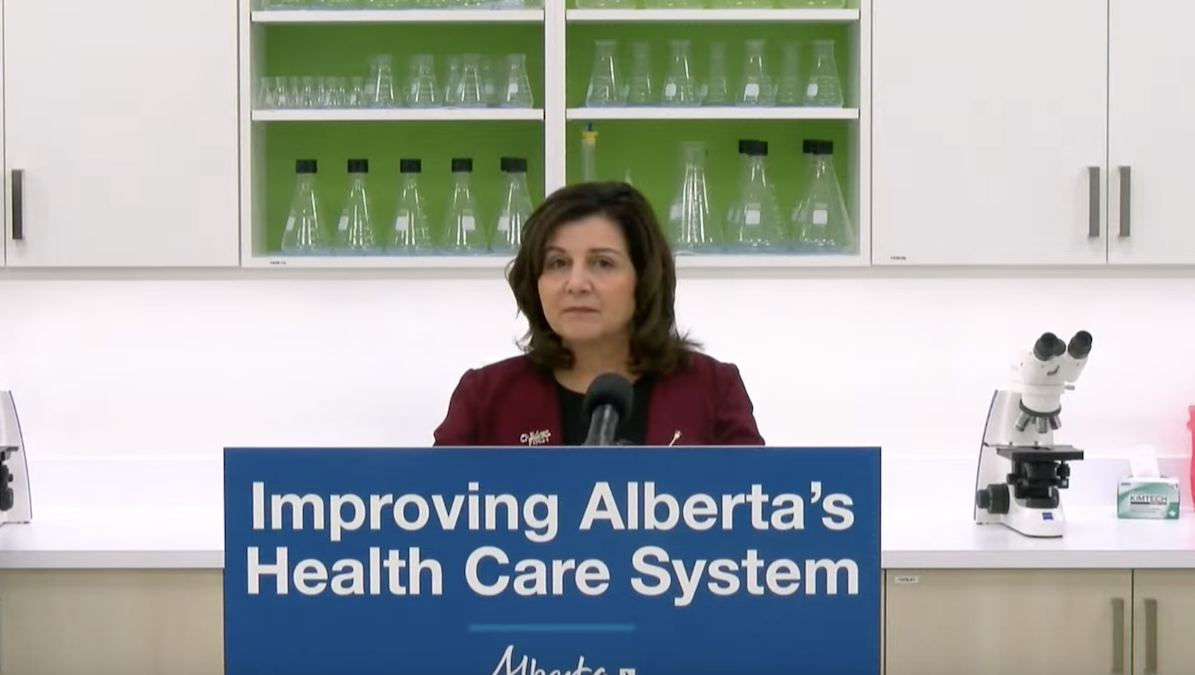Alberta Premier Danielle Smith, lifelong advocate of private health care, moved unexpectedly Friday to nationalize the province’s recently privatized medical lab services.
Health Minister Adriana LaGrange made the announcement at what looked like a hastily organized press conference in Red Deer, but she made it clear the deed was done on Smith’s instructions.
“An agreement in principle has been reached with ownership of DynaLife to transfer staff, equipment and property in all regions of the province to Alberta Precision Laboratories,” the government said in the news release it published Friday afternoon. “This work will be completed in phases with the full transition expected to be completed by December 2023.”
DynaLife Medical Labs is the private company, that had operated successfully in the Edmonton area for years, that the government allowed to take over medical lab services in Calgary in December 2022, with disastrous results.
The government claimed the deal would save $18 million and the health minister at the time, Jason Copping, promised “this change really sums up the rationale for contracting: enhanced services at a lower cost. First and foremost, it will give Albertans more and better services.”
Alberta Precision Laboratories (APL) is the wholly owned subsidiary of Alberta Health Services, the province’s public health agency, which efficiently operated Calgary public medical testing until the DynaLife takeover last year. APL continued to be responsible for medical lab tests within Alberta hospitals after the privatization.
No one has explained why, but the privatization was a fiasco from the get-go. Simple medical tests in Calgary and southern Alberta took longer and longer for patients to get. With its lab privatization scheme in a shambles, the government was forced in August to turn to APL in a desperate bid to keep the system from collapsing.
But who saw “de-privatization,” as The Canadian Press squeamishly put it, coming?
Hardly anyone, judging from the instant commentary on social media Friday.
Well, two things are for sure:
One, things must have been even worse than anyone imagined in Calgary for a government run by Smith to take such a dramatically out-of-character step to remedy it.
Two, notwithstanding her impeccable market-fundamentalist credentials, Smith risks being struck from the Christmas card lists of organizations like the Fraser Institute and the Canadian Taxpayers Association for this!
Jason Kenney, the province’s former United Conservative Party premier who pulled the plug on the previous NDP government’s plan to build a province-wide medical super-lab in Edmonton shortly after his election in 2019 must be spinning like a top, wherever he’s hiding out nowadays.
Tyler Shandro, who was Kenney’s first health minister, tweeted angrily in July 2019 : “The real purpose of the superlab was to nationalize Dynalife for $50 million of taxpayers’ money in 2022. That agenda was sheer ideology and we cancelled it. Instead we’ll work with the lab system to meet the priority needs for patients.”
Today, Shandro is a private citizen, presumably between jobs since the May 29 provincial election. And it sounds very much as if the dark NDP plot Shandro described is about to be realized by Kenney’s successor!
In a news release Friday, NDP Health Critic Luanne Metz, a physician, pointed out that “DynaLife is the provider selected by the UCP after they destroyed Alberta’s publicly owned lab system in 2019 and embarked on a three-year dedicated drive to privatize its crucial work.
“Now that public lab has to bail out DynaLife,” she continued. “This is the UCP’s reckless experiment in privatization – all the money goes to a private operator, and all the risk lands on Alberta taxpayers and Alberta families. … This is pure incompetence.”
This raises a crucial question about Friday’s announcement – which LaGrange failed to answer. To wit: How much is this “de-privatization” going to cost?
“I’d love to know how much this misadventure has cost the taxpayer,” tweeted former Calgary mayor Naheed Nenshi. “What were the contract break fees on the super lab? How much was Dynalife being paid under the sole-source (was it?) contract? What are the new break fees? Who are DynaLyfe’s lobbyists and their payment?”
One imagines that when all the dust has settled, the cost of the entire privatization scheme will considerably exceed the $50 million Shandro complained about in 2019.
For her part, LaGrange described the takeover as “a mutual agreement” and told a reporter that Alberta Health Services is still in negotiations with DynaLife’s owners – North Carolina-based Laboratory Corp. of America and the Ontario Municipal Employees Retirement System. “We have a memorandum of understanding but the final details are still being worked out.”
The cost, she said, “is not something that I can share. But as we move forward, we will be able to make that readily available to the public. We want to be transparent.”
The nationalization will also have impacts for the Health Sciences Association of Alberta , the union that represents APL and DynaLife employees.
Last year’s privatization resulted in HSAA members being treated differently depending on whether or not they were transferred from the public system. Last month, HSAA successfully negotiated an agreement that was supposed to get its members to parity by 2025. Now that all of them will be APL employees by the end of this year, presumably, parity will come sooner.
I’m pretty sure the last time anything like this happened in Alberta, maybe the only other time, was when Peter Lougheed’s government acquired a majority interest in Pacific Western Airlines, which did most of its business in Alberta, and moved the company’s headquarters from Vancouver to Calgary.



